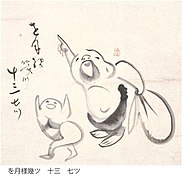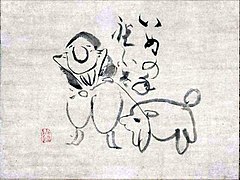Sengai
Sengai Gibon ( Japanese 仙厓義梵 , more artist name Ayo (唖羊) Kyohaku (虚白), Muhōsai (無法斎); born: 1750 in the village of Taniguchi in the province of Mino (now Gifu Prefecture died) November 4 1837 ) was a Japanese Rinzai-shū monk and Zen painter. He was known for his controversial teachings and writings, and also for his light-hearted sumi-e paintings.
Life
Sengai became a monk under Kūin, a priest of the Seitai-ji temple in the vicinity of his homeland. Later he received a Zen education under Gessen Zenne des Tōki-an in today's Yokohama, which certified him the successful completion of the Zen master. Then Sengai went to Hakata on Kyūshū and trained further in Zen under the priest Bankoku, who worked on the local Shōfuku-ji .
While Sengai devoted himself to religious studies with great earnestness, he responded to the wishes of the crowd and produced a large number of Zen-typical drawings that were full of zest and resembled the formulation of haiku . His name was soon linked to the name of the other great Zen painter of his time, Hakuin . The two were summed up with the saying "Hakuin of Hara in the east - Sengai of Hakata in the west".
Sengai's paintings do not quite have Hakuin's strength - the brushwork even seems clumsy and somewhat childlike at first glance - but the texts in the pictures are often very humorous. - It is said that Sengai created the pictures not only for their own satisfaction, but also as a basis for a better understanding of Zen Buddhism for ordinary people.
In his later years, Sengai lived in seclusion in a sub-temple called Kyohaku-in. Posthumously he was given the name Fumon-in Entsū Zenji. - His most famous works include hanging scrolls depicting Hanshan and Shide , this famous couple of eccentric monks. The hanging scrolls are in the Eisei Bunko , in the collection of the Hosokawa clan .
Teaching
Although the Rinzai-shū was particularly known for its difficult to understand teachings, Sengai tried to make them available to the public.
In the 20th century, Idemitsu Sazō in particular collected his works and made them available to the public in his museum, the Idemitsu Art Museum .
Circle, triangle and square
One of his most famous paintings shows a circle, a square and a triangle (which the Japanese usually associate with “right”, “half right” and “wrong”).
This painting was titled "Universe" by Daisetz Taitaro Suzuki, who made Sengai known in the western world and who freely translated many of the inscriptions into English.
photos
Remarks
- ↑ There are several versions of this topic.
literature
- Daisetz T. Suzuki : The Zen Master Sengai. Ink pictures and poems. Edited by Eva von Hoboken. Cologne: DuMont 1985; ISBN 3-7701-1605-4
- Tazawa, Yutaka: Sengai . In: Biographical Dictionary of Japanese Art. Kodansha International, 1981. ISBN 0-87011-488-3 .
| personal data | |
|---|---|
| SURNAME | Sengai |
| ALTERNATIVE NAMES | 仙 厓 義 梵 (Japanese); Sengai Gibon |
| BRIEF DESCRIPTION | japanese buddhist monk |
| DATE OF BIRTH | 1750 |
| PLACE OF BIRTH | Taniguchi, Mino Province , now Gifu Prefecture |
| DATE OF DEATH | November 4, 1837 |




